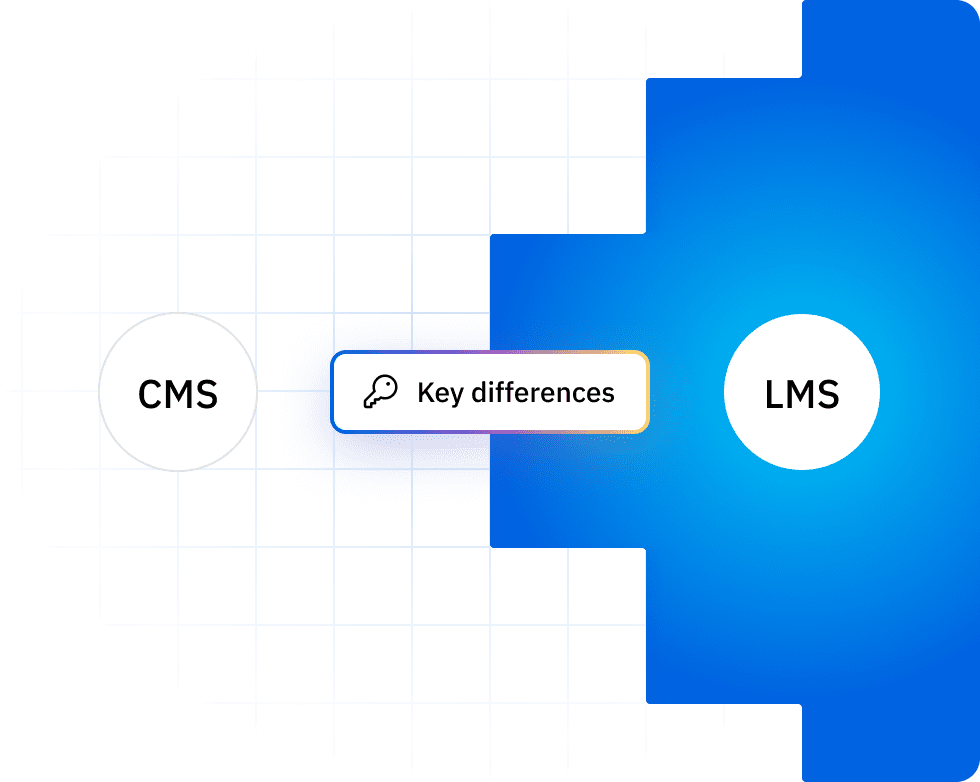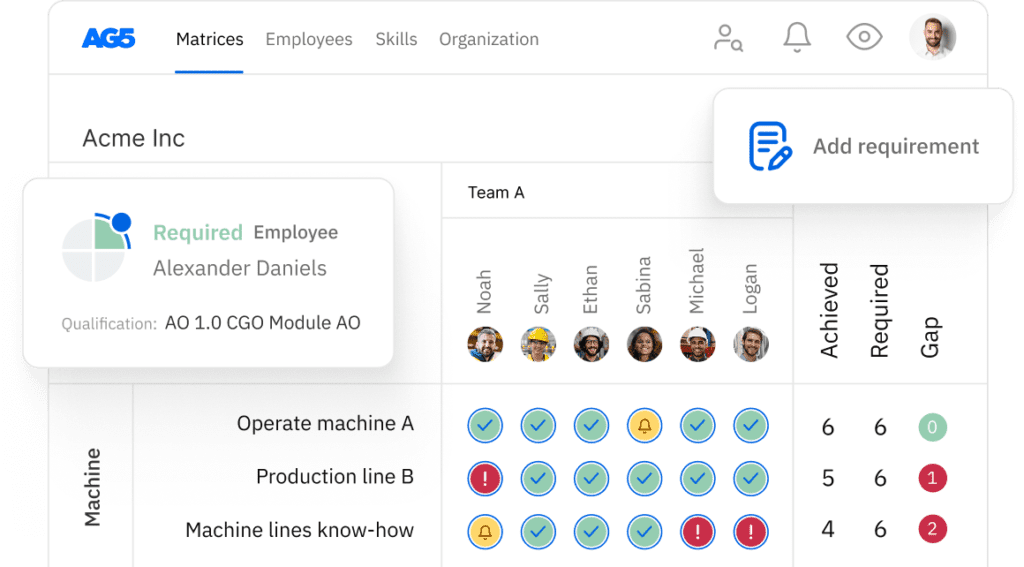Competency management system vs LMS: key differences
A competency management system (CMS) validates on-the-job capability with role-based skills, evidence, and audit readiness, while a learning management system (LMS) delivers and tracks training. Used together, they close the loop from gap detection to learning delivery to verified competence.

TL;DRCopied
A CMS assures capability on the job with role-based competencies, proficiency levels, and audit-ready evidence. An LMS scales training delivery and tracks completions. Use both: CMS to identify and verify gaps, LMS to assign and deliver learning. Integrate early, standardize your skills library, and manage by gap-closure metrics.
What is a competency management system?Copied
A competency management system (CMS) defines, assesses, and tracks the competencies your workforce needs to perform safely and effectively.
It does this using structures like role profiles, skills matrices, assessments, and audit-ready evidence. It turns “who can do what?” into real-time, verifiable data.
A CMS centers on outcomes at work, not just learning activity. Practically, you’ll model roles, map the competencies required, and collect evidence through self, manager, and on-the-job assessments.
Good platforms provide skills matrices, expiry alerts, succession visibility, and reporting that stands up in audits.
If you’re moving away from “Excel hell,” look for live skills tracking, certificate management, and clear proficiency levels that align with your internal competency framework.
Suggested visual inside this section: a screenshot-style diagram of a role-based skills matrix showing proficiency levels and expiring certs.
What is a learning management system (LMS)?Copied
An LMS delivers and tracks learning—courses, e-learning modules, virtual classes, and certifications—so you can standardize onboarding and development and report on completions and scores at scale.
LMS platforms excel at content delivery and progress tracking. They offer catalogs, learning paths, quizzes, SCORM/xAPI support, and robust scheduling.
Their core value is getting the right training to the right people and proving completion with transcripts. Many teams use an LMS to drive compliance learning and role-based pathways.
Where an LMS stops, however, is the jump from “course finished” to “competency proven on the job.” That’s where a CMS picks up, by validating proficiency in real contexts and maintaining evidence for audits.

How do CMS and LMS differ in purpose and function?Copied
A CMS validates on-the-job capability and closes gaps; an LMS delivers learning to address those gaps. Together, they form a feedback loop: assess → assign → learn → verify → report.
Skills visibility vs content delivery
- CMS: Role-based visibility of proficiency, gaps, and expiries
- LMS: Delivery of courses and programs to build knowledge
- Together: CMS flags a gap and triggers the LMS to assign the right course, then pulls results back for verification
Competency tracking vs learning progress
- CMS: Evidence of competence from observations, checklists, and assessments
- LMS: Completion status, scores, seat time, and learning paths
- Together: Move from “completed training” to “demonstrated proficiency,” improving safety and quality outcomes
Compliance and audit support
- CMS: Certificate vault, auditable trails, real-time skills matrices for inspections
- LMS: Proof of assigned and completed training for regulated roles
- Together: End-to-end traceability—requirement → assignment → completion → competence verified. Add a small comparison table inside this section:
| Dimension | CMS focus | LMS focus |
|---|---|---|
| Primary goal | Assure competence on the job | Deliver and track learning |
| Data model | Roles, competencies, proficiency | Courses, modules, completions |
| Evidence | Observations, checklists, artifacts | Scores, transcripts, attendance |
| Audit use | Skills matrix, expiry alerts | Training records, assignments |
Do competency management systems integrate with LMS platforms?Copied
Yes. Modern CMS platforms integrate with LMS tools so detected skill gaps can auto-assign training, and completions flow back to update proficiency—minimizing manual admin and speeding time-to-competence.
Integration closes the loop. Typical workflow: the CMS identifies a gap for a role (e.g., “forklift re-certification due in 30 days”), then pushes a course assignment to the LMS; upon completion, the LMS returns results to the CMS, which updates the skill status and documentation.
This reduces scramble before audits and prevents lapsed certifications. If you’re evaluating platforms, prioritize open APIs, off-the-shelf LMS connectors, and bidirectional data flows.
Place an integration flow diagram here to visualize gap detection → LMS assignment → completion → CMS verification.
How to implement a competency management systemCopied
Start with a clean competency model and a role-based skills matrix. Pilot with a critical function, then scale with assessments, evidence capture, and integrations for training and HR data.
A reliable implementation avoids boiling the ocean. Use this staged plan:
- Define your competency library Build a lean, role-anchored library with clear proficiency levels. Keep naming consistent and map each competency to business risks or outcomes. Use skills management software to centralize definitions and version control.
- Model roles and build matrices Create matrices for priority teams. Use skills matrix templates to accelerate standardization and ensure coverage for safety-critical tasks.
- Establish assessment workflows Combine self, manager, and on-the-job observations. Capture evidence (photos, sign-offs) and ensure calibration so ratings are consistent.
- Integrate with learning Link each competency to a training path in your LMS. Automate assignments for gaps and expiries to avoid manual chasing.
- Prove compliance and measure impact Track audit-ready documentation, closure time for gaps, and mobility outcomes. Expand to more departments only after your pilot is reliable and repeatable.
Suggested asset inside this section: a one-page checklist titled “CMS implementation quick start” with steps, owners, and timelines.
How LMS platforms help organizations develop talentCopied
LMS tools scale learning efficiently—standardizing onboarding, assigning training by role, and reporting on completions and scores across locations and shifts. They’re indispensable for consistent delivery.
At their best, LMS platforms standardize how training is delivered and measured. Use them to roll out regulatory training, onboarding, and advanced pathways for emerging job families.
Modern LMSs support blended learning, micro-learning, and skills-based learning paths. For leadership pipelines or regulated environments, templates and learning plans accelerate readiness while giving managers visibility into who’s completed what.
Inside this section, include a mini-table of common LMS use cases: onboarding, safety certifications, product rollouts, and leadership programs—each tied to a measurable KPI like time-to-productivity or compliance completion rate.
How to conduct a competency gap analysisCopied
Compare required competencies per role with current proficiency levels, quantify the gaps, and link each gap to targeted training and on-the-job practice.
Visualize it in a skills matrix and act on the results.
Run a focused analysis like this:
- Clarify role requirements Use up-to-date role profiles with clear proficiency thresholds
- Collect current state Gather self, manager, and observed assessments with evidence
- Map gaps Use a matrix view by team and site; highlight high-risk gaps and expiries
- Assign action Link each gap to a course, coaching, or practice opportunity in the LMS
- Track closure Monitor progress weekly until gaps fall to acceptable thresholds
For teams new to this, start with a competency gap analysis primer and a ready-made skills matrix layout. Add a simple heatmap mockup as the image suggestion in this section.
Why both systems are essential to workforce readinessCopied
A CMS verifies competence; an LMS builds it.
Together they provide a complete system of record—from requirement to training to proof—supporting safer operations, faster upskilling, and fewer audit surprises.
Organizations often try to make an LMS “do CMS things” or vice versa. That leads to blind spots: either you can’t prove proficiency, or you can’t scale training delivery.
Pairing the two gives you a closed loop. The CMS provides risk-based visibility and audit defense; the LMS provides scalable delivery and engagement.
Use the CMS as your competency source of truth and the LMS as your training engine. Add a small diagram here: circular loop showing Assess → Assign → Learn → Verify → Report with data flowing both ways.
ConclusionCopied
If your priority is skills visibility, compliance, and mobility, lead with a CMS. If you need standardized training delivery, lead with an LMS.
Most enterprises benefit from an integrated stack—and clear governance between the two. When evaluating, weigh use cases by impact and urgency.
Manufacturing, healthcare, and other regulated environments gain immediate value from a CMS-first approach for audit readiness and risk reduction, while tech and services teams might lead with an LMS to unify global learning paths.
Whichever route you take, standardize role definitions, align proficiency levels, and integrate early. For a deeper primer on the skills landscape, bookmark skills management and skills proficiency resources.
FAQs Copied
-
What is the main difference between CMS and LMS?
-
Can an LMS replace a CMS?
-
Which should I implement first?
-
Do CMS platforms integrate with popular LMSs?
-
How do I structure competencies?
-
What evidence counts toward competence?
-
How does this help leadership development?
-
What are typical LMS benefits?
Author Copied
Revisions Copied
Written by: Rick van Echtelt
Copy edited by: Adam Kohut

